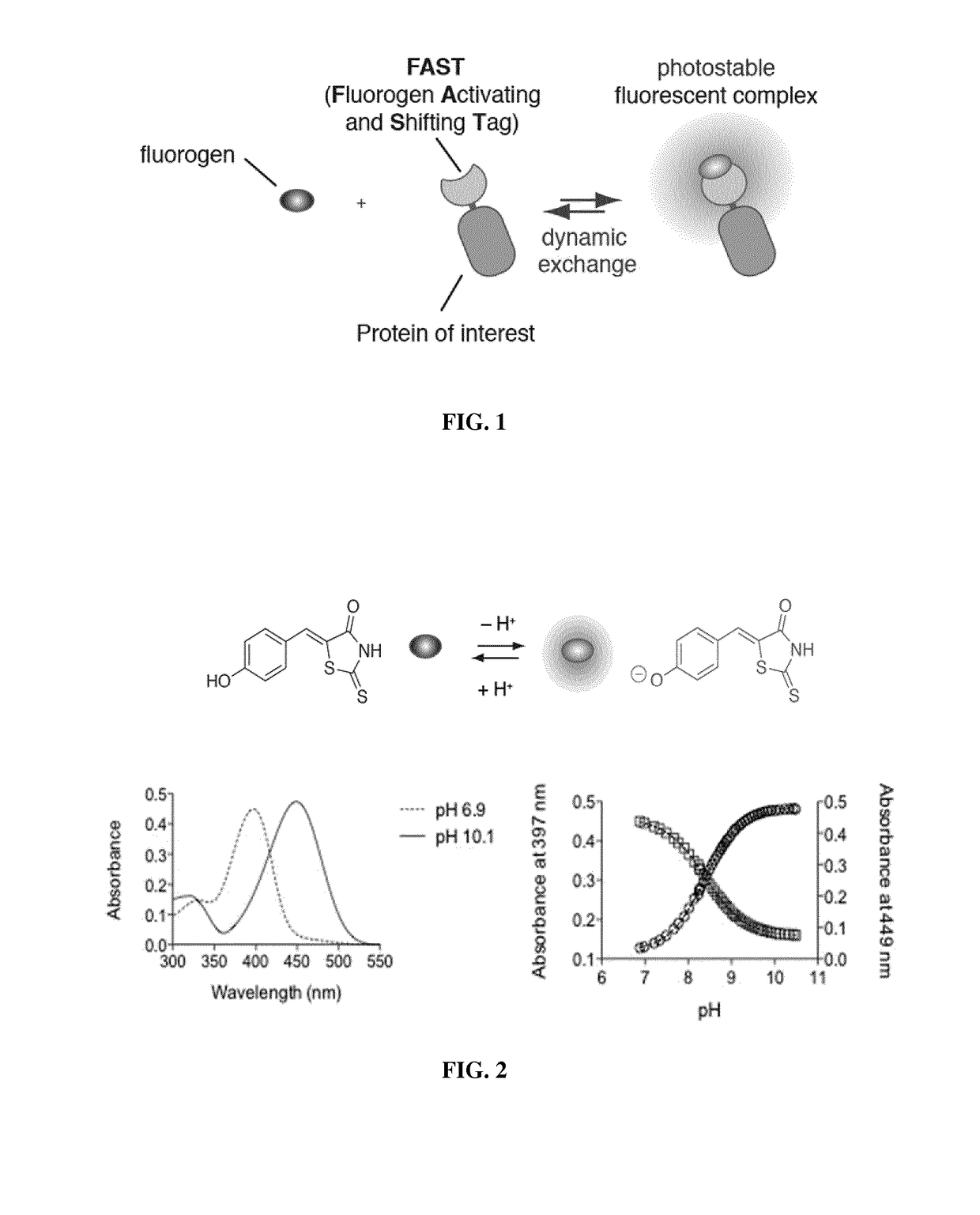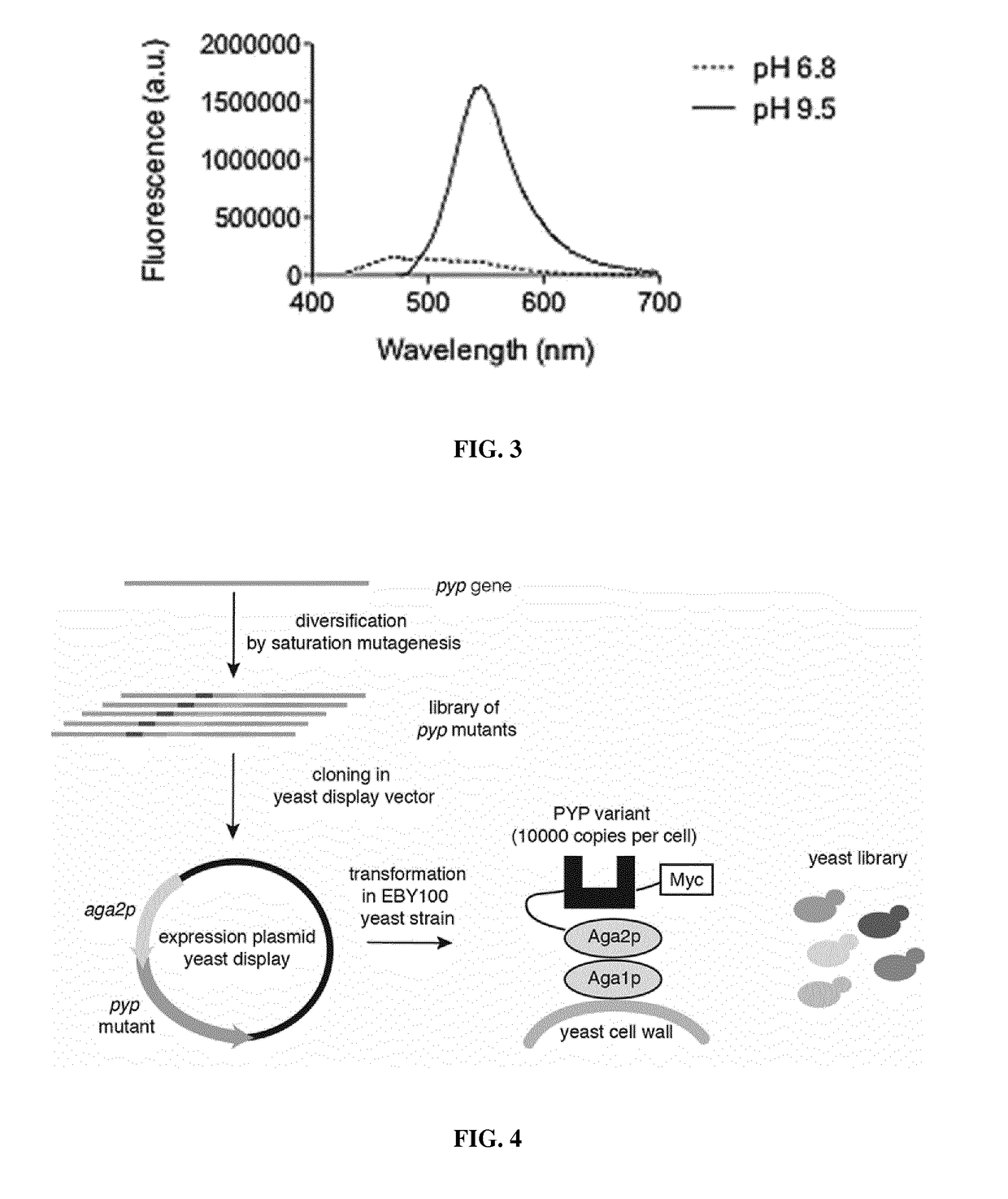Fluorogen activating and shifting tag (FAST)
a fluorescent protein and activating tag technology, applied in the field of protein fluorescence labelling, can solve the problems of limiting the use of such fluorescent proteins in the environment, unable to observe for a long time, and suffering from several limitations in the approach, so as to avoid the effect of photobleaching
- Summary
- Abstract
- Description
- Claims
- Application Information
AI Technical Summary
Benefits of technology
Problems solved by technology
Method used
Image
Examples
example 1
a New Fluorogenic Chromophore—Identification of HBR
[0279]A fluorogenic chromophore capable to show high fluorescence increase when immobilized in a rigid environment such as a protein cavity, and exhibiting a shifted absorption upon ionization of an auxochromic group was designed.
[0280]It is known in the art that the chromophore of GFP, i.e. parahydroxybenzylidene-5-imidazolinone (p-HBI), displays an extremely weak fluorescence quantum yield when the protein is unfolded, but said fluorescence quantum yield increases by 104-fold in the barrel tertiary protein structure (Heim et al., 1995; Tsien, 1998). Further, the protonated form of p-HBI absorbs at 397 nm while its deprotonated form absorbs at 475 nm. These photophysical properties of p-HBI originate from its typical donor-acceptor conjugated structure, where phenol / phenolate act as electron-donating groups and the imidazolidinone ring acts as the electron-withdrawing group.
[0281]New fluorogenic chromophores were designed, upon ret...
example 2
PYP Derivatives
[0289]Fluorescent HBR-binding proteins were designed by remodeling the active site of the C69G photoactive yellow protein (PYP) from Halorhodospira halophila of SEQ ID NO: 48.
[0290]PYP is a 14 kDa monomeric disulfide-free blue-light photoreceptor, whose photosensing behavior relies on the photoisomerization of a para-hydroxycinnamoyl (HC) chromophore covalently attached to Cys69. The monomeric state and small size of PYP render this protein very attractive to design a new protein tag.
[0291]A directed evolution strategy of PYP was designed, based on yeast display, for remodeling the chromophore pocket of the apo-PYP-C69G of SEQ ID NO: 48 in order to obtain a cavity able to bind HBR in its basic blue-absorbing state and enhancing its fluorescence. The choice of apo-PYP as starting scaffold was driven by the likeness of the structures of HBR and the natural HC chromophore of PYP. Additionally, as the binding pocket of apo-PYP accommodates the HC chromophore in its deprot...
PUM
| Property | Measurement | Unit |
|---|---|---|
| temperature | aaaaa | aaaaa |
| maturation time | aaaaa | aaaaa |
| dissociation constant | aaaaa | aaaaa |
Abstract
Description
Claims
Application Information
 Login to View More
Login to View More - R&D
- Intellectual Property
- Life Sciences
- Materials
- Tech Scout
- Unparalleled Data Quality
- Higher Quality Content
- 60% Fewer Hallucinations
Browse by: Latest US Patents, China's latest patents, Technical Efficacy Thesaurus, Application Domain, Technology Topic, Popular Technical Reports.
© 2025 PatSnap. All rights reserved.Legal|Privacy policy|Modern Slavery Act Transparency Statement|Sitemap|About US| Contact US: help@patsnap.com



